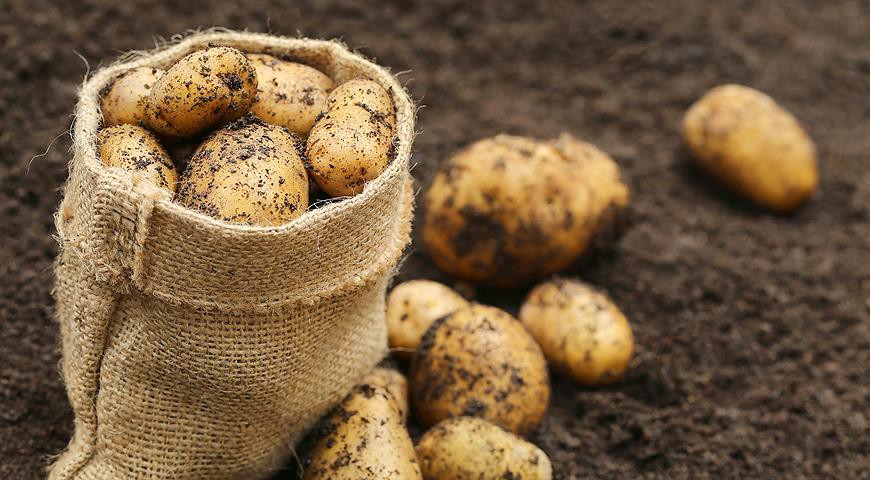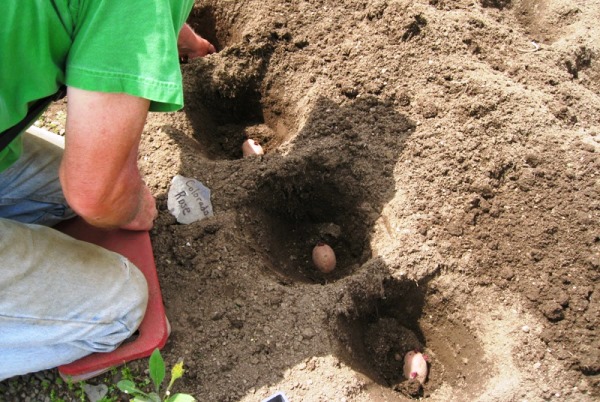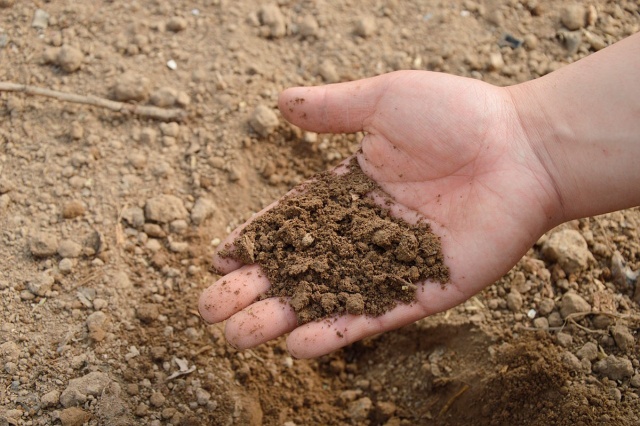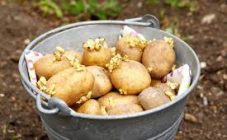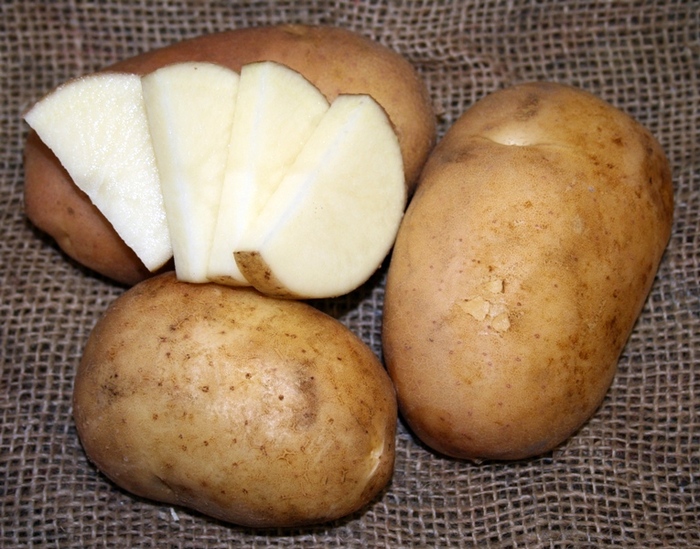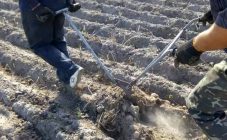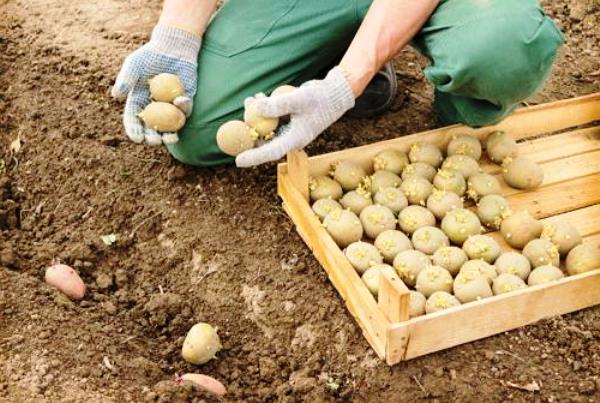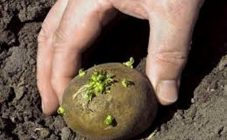Almost all gardeners and gardeners grow potatoes. This culture is the basis of many dishes and is included in the diet of most people.
Description of culture
The potato is a perennial tuberous crop. Most often it is grown as an annual plant, since its entire life cycle fits within a single growing season.
Any potato variety reproduces vegetatively - with the help of tubers. In addition, the plant can be propagated by sprouts, cuttings and parts of tubers. In the practice of breeders, it is often used and propagated by seeds.
Potatoes belong to the Solanaceae family. The stems of most varieties are erect, in some cases they may deviate somewhat to the sides. The color of the stems in the majority of varieties is green. Leaves are simple, entire. As the culture grows, intermittently-pinnate leaves begin to form. Each of these leaves has several pairs of lateral lobes, which are located opposite one another, intermediate lobes and the final lobe.
Potato flowers grow in inflorescences that outwardly resemble diverging curls. Potatoes are self-pollinating plants, but most varieties are sterile. Few remain fertile.
The fruit of a potato is not a root tuber, but a two-celled green oval or spherical green berry. Once ripe, the fruit turns white and takes on a strawberry-like aroma. Potato berries are not eaten.
The root system of the culture (provided that it is grown from a tuber) is fibrous. The tuber is a thickened short stem. Ripe potatoes are covered with a thin skin that prevents the tubers from drying out. It also protects the culture from many diseases. The starch content of potato tubers can vary from 12 to 29%.
At what temperature to plant potatoes
Since potatoes are a culture, without which it is simply unrealistic to imagine the menu of a modern person, there is nothing surprising in the fact that everyone who has the opportunity is trying to plant this culture on their personal plot.
When cultivating potatoes, the timing of planting is of great importance. In this case, a particularly important factor is the temperature regime, especially the temperature of the soil for planting potatoes in spring.
Everyone knows that the time of planting a potato crop has a huge impact on the yield and quality of tubers. Many gardeners prefer not to delay with this type of work, such as planting potatoes in open ground. This is due to the following reasons:
- early planting allows you to get a harvest earlier and, after a minimal time period, begin to feast on fresh young vegetables;
- according to experts, early planting of potatoes helps to protect the crop, both from pests and from most diseases;
- the earlier the potatoes are planted, the higher the yield will be.
So, for example, if potatoes are planted before May 15 in the north-western region of the country of Russia, the yield will be at least 1500% of the planted amount. Similar figures for planting at the end of June are already only 500%.
But landing too early is also a certain risk. If the weather after planting is too cold, the potatoes may freeze.So, when planning to place planting material in open ground, one should take into account a number of significant factors: weather conditions, soil condition, its temperature, heating rate and, finally, the physiological state and characteristics of the tubers themselves.
The most difficult thing, in fact, is to calculate the weather conditions in advance. Often they are so unpredictable that they can destroy any landing plans focused on the climate and its features. Despite this, a couple of weeks before the potato cultivation begins, it is imperative that you familiarize yourself with the weather forecast.
As for the condition of the soil, not one factor should be taken into account, but two: moisture and temperature. The optimal soil for planting potatoes should have a temperature of +7 degrees at a depth of at least 10 centimeters.
The fact is that it is at the indicated temperature that active growth of the root system of the culture is possible. If the temperature is lower and the humidity is high, the potatoes will simply rot in the soil and will not rise.
Long-term horticultural practice shows that potato sprouts are able to survive and even grow slowly, starting from +3 degrees. They will not be able to endure negative temperatures. Given this, if at the time of planting it is rather cold, but in the coming days forecasters promise a sharp and serious warming, it is allowed to take the risk of opening the planting season for potato crops.
Soil moisture at the beginning of planting work should not exceed over 75%. This will inevitably lead to infection of tubers with fungal diseases and bacterial infections.
It is possible to determine the humidity indicator without special devices. You need to take a handful of earth and squeeze it carefully. The resulting lump should be thrown to the ground. If it crumbles, you can plant potatoes - the moisture indicator is within normal limits. If nothing happens to the lump, certain adjustments will need to be made to the landing plans.
As for the physiological state of tubers, they can be planted in the ground both in the ordinary state and in the germinated state. Seedlings are allowed in different lengths. Experts recommend using tubers with fairly strong and thick seedlings, the length of which is 2-3 centimeters. Sprouted tuber is allowed to be planted in colder soil. The ground temperature for planting such potatoes can be as low as +3 degrees.
Small tubers, which weigh between 35 and 50 grams, are best suited as seed. On fertile soils, they should be laid to a depth of 10 to 12 centimeters, depending on the specific weather conditions.
If we are talking about a region with a high level of moisture and loamy soils, potatoes should be planted on ridges and beds.
Before planting, it will not be superfluous to vernalize the tubers. The operation is quite simple. Tubers prepared for planting are placed in boxes and placed in a warm place with good lighting. It is in such conditions that it is easiest to get short and strong enough shoots. In some cases, vernalization is performed on a wire and a sword. In this case, the tubers should be strung on the wire in about 3 weeks.
Folk ways of determining the timing of planting also exist. Some gardeners put their bare feet on previously prepared and dug soil, and then listen to their own feelings. If your foot is relatively comfortable, it means you can start planting potatoes.
Which method of checking the soil temperature to choose is up to the gardener himself.But if all of the above seems to be insufficiently reliable, and there is no rush in planting potatoes, it is quite acceptable to wait for a more significant warming and plant a crop when the risk of frost is minimal. The best soil temperature for planting potato tubers is considered to be the temperature range from +12 to +15 degrees. Such indicators correspond to an air temperature from +17 to +20. Planting late may cause problems with plant moisture. But if necessary, it can be solved by watering. The most important thing is to notice the problem in time and begin to take measures to eliminate it.
Potatoes are considered the second bread in Russia. In this regard, the desire of both experienced and novice gardeners to get an extensive and tasty harvest is absolutely understandable.
